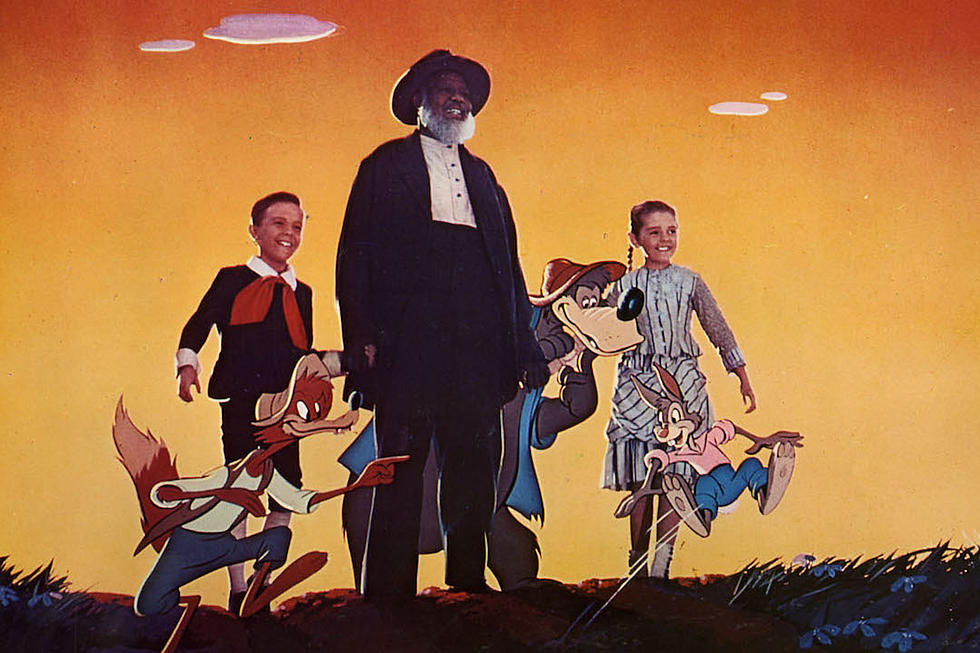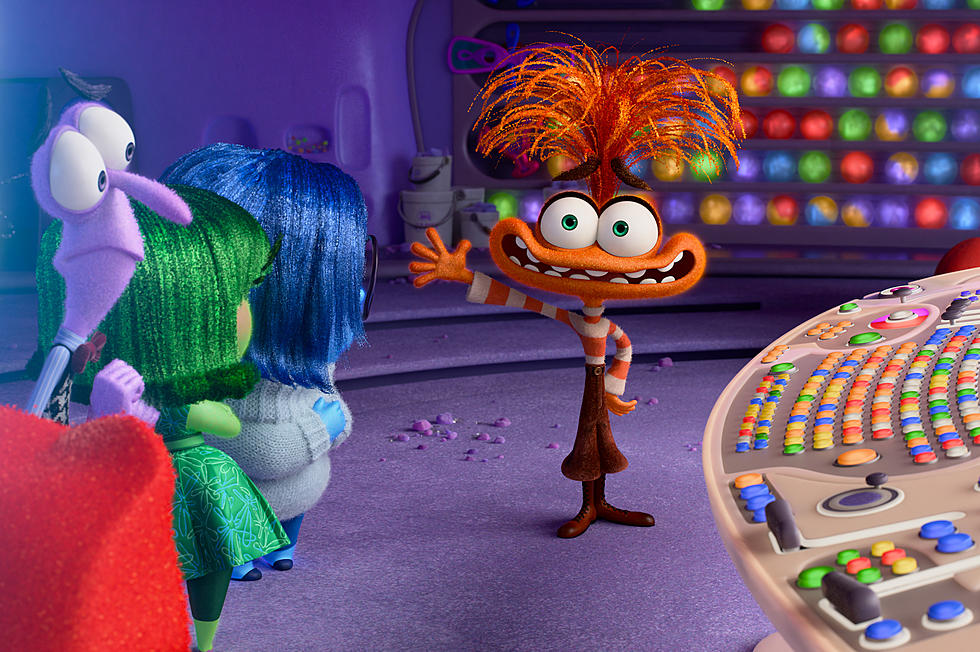
Just How Racist Is ‘Song of the South,’ Disney’s Most Notorious Movie?
At the western edge of Disneyland rises a craggy peak of mossy cliffs, tangled tree roots, and thorny briar patches. This attraction — part animatronic stage show, part kid-friendly log flume — is known as Splash Mountain, and thanks to the technical wizards at Walt Disney Imagineering, it really looks like an authentic summit. But of course, it’s not; the whole mountain was built in the late 1980s at a reported cost of some $75 million. It’s a very fun ride — and possibly the strangest in the entire Disney empire, since it’s essentially a towering monument to a movie that Disney has kept out of circulation for more than 30 years.
That movie is Song of the South, a 1946 live-action/animation hybrid directed by Harve Foster and Wilfred Jackson. Based on the collected Uncle Remus stories of author Joel Chandler Harris, the film follows an innocent young boy from Atlanta named Johnny (Bobby Driscoll) who moves with his mother to his grandmother’s plantation. (His father remains in Atlanta to work as a newspaper editor.) On the plantation, Johnny learns a series of life lessons from Uncle Remus (James Baskett) in the form of stories about the animated Br’er Rabbit (voiced by Johnny Lee) and his quest to evade Br’er Fox (Baskett) and Br’er Bear (Nick Stewart). Included amongst these cartoon interludes is “Zip-a-Dee-Doo-Dah,” which won the Oscar for Best Original Song and is one of the most famous and beloved tunes in the Disney library.
“Zip-a-Dee-Doo-Dah” is quintessential Disney; simple, sunny, and utterly uncomplicated. But the history of Song of the South is as thorny as the briar patch that Br’er Rabbit calls home. Though Disney rereleased the film several times through the mid- and late-20th Century, it was trailed by persistent accusations of racism. After a return engagement in 1986 in celebration of Song of the South’s 40th anniversary, Disney locked the film away in its vault. To date, it has never been released in the United States on any home video format. When Disney CEO Robert Iger was asked in 2010 if fans would ever see a Song of the South DVD, he called the movie “antiquated” and “fairly offensive,” and said there were no plans to make a DVD or Blu-ray. Six years later, Disney still hasn’t.
Though Disney has done its best to keep Song of the South hidden from view, it’s tough to hide a giant amusement park ride, where robotic versions of Br’er Rabbit, Fox, and Bear (though not, it should be noted, Uncle Remus) entertain thousands of guests every day. It’s also hard not to think about Song of the South while reading reviews of Disney’s new movie, Zootopia, which have been almost uniformly positive, and especially impressed by the movie’s treatment of race. Forbes’ Scott Mendelson called Zootopia a “new Disney classic” while hailing its “strikingly blunt and unrelentingly committed race relations parable.” Buzzfeed’s Alison Willmore says the film is “boldly and almost jarringly ambitious” in its tackling of social issues. In the words of ScreenCrush’s own Oliver Whitney, Zootopia is Disney’s “most important and political film yet.”
On the eve of the release of perhaps the most important and political animated feature in Disney’s long history, it seemed like the ideal time to look back at the studio’s most notorious movie. Is it worthy of the years of controversy? Is Disney right to keep it unreleased? Or is the whole thing overblown? Just how bad is it?
It’s pretty bad.
Granted, nothing in the film comes close to matching the virulent racism of a film like The Birth of a Nation, D.W. Griffith’s silent epic about the “heroic” efforts of the Ku Klux Klan to protect the post-Civil War South from former slaves (played by white actors in blackface). Song of the South’s African American characters are treated warmly, particularly Uncle Remus, who is Johnny’s best friend and confidant, a charismatic storyteller, and, most importantly, the film’s conduit to the animated world of Br’er Rabbit. (Baskett was given an honorary Oscar for the role.)
The problem isn’t necessarily what Song of the South depicts, but what it chooses not to depict. Although Harris’ Uncle Remus stories were set in Georgia after the Civil War, the film adaptation never makes it clear when the story is taking place. Wikipedia tells me that if you’re an expert in Reconstruction-era clothing, you’d recognize Johnny and his family’s late-Victorian wardrobe. But for the rest of us dopes, there’s no indication when the film is set. If you’re not a scholar or an Uncle Remus expert, it’s very easy to assume that the film is set before the Civil War, and that Remus and Aunt Tempy (Hattie McDaniel) are slaves — and that they are completely fine with that.
No one expects a serious meditation on racial identity in a Disney children’s film (at least until they see Zootopia), but even by the company’s generous standards, Song of the South’s version of the South is sanitized in the extreme. Like “Zip-a-Dee-Doo-Dah,” this is quintessential Disney; just not in a good way. Here “utterly uncomplicated” applies to the way they strip any sense of politics, history, or ideology out of this setting to make it palatable to a mainstream audience. Most Disney movies are set in an ill-defined and idealized past, and that’s fine when you’re making a movie about a princess who lives in a magic kingdom. When you’re making something about 1800s Georgia? It’s more of an issue.
The words “slave” and “slavery” are never uttered, and the specifics of the economic relationship between the blacks and whites (Master and slave? Employer and servant?) are left deliberately vague. By stripping out any concrete details of time and place, Disney essentially turned the plantation system into a ludicrous utopia where blacks and whites live in harmony — a harmony where the only thing that’s clear is that the blacks are inferior and servile to the whites, but are content to work the fields anyway.
As gorgeously animated as the Br’er Rabbit sequences are, their messages don’t exactly help Song of the South’s case in the offensiveness department either. Several of Remus’ stories are about Br’er Rabbit wanting to run away from his problems; the moral, inevitably, is that you can’t avoid trouble and there’s no place like home. These lessons are particularly important to Johnny because he doesn’t like life on the plantation initially and wants to run away to live with his father in Atlanta. But when coupled with the African American characters’ oddly cheerful attitude about their social status, the movie seems to be arguing on behalf of complacency. Don’t leave the plantation, don’t try to better yourself. Just go with the flow. (One of the animated shorts — the one that gets recounted in the animatronic portions of Splash Mountain, in fact — involves Br’er Rabbit getting stuck in a “tar-baby.” While the cartoon itself isn’t necessarily about race, the use of that term as an insult towards African Americans is yet another strike against the film. And no, the “tar-baby” doesn’t appear in Splash Mountain; instead, Br’er Rabbit gets stuck in a beehive.)
I don’t think any of this was intentional. I believe that Disney saw Uncle Remus as an unequivocally positive character. Some critics have observed a kinship between Uncle Remus and “Uncle Walt” — men with an unshakeable belief in the power of stories who’ve dedicated their lives to entertaining and educating children. Although Johnny’s mother repeatedly orders Remus not to tell Johnny any more stories, those same stories eventually save Johnny’s life. At the end of the film, Remus’ words seem to heal Johnny after he’s suffered a potentially deadly injury. It’s very possible that Disney had good intentions — and still wound up with a very questionable movie.
Song of the South fans often talk about those good intentions, and of the film as a “product of its time,” as Songofthesouth.net does in its “humble defense” of the movie. As modern views have evolved, so has our opinion of Song of the South, which was made to reflect the attitudes at the time of its production. That may not be entirely true, though. Protests of Song of the South are almost as old as the movie itself. On December 14, 1946, less than a month after the film’s premiere, The New York Times reported on a picket line outside Manhattan’s Palace Theater, where protesters carried signs that read “We fought for Uncle Sam, not Uncle Tom” and “The Song of the South is slightly off-key because Disney says it’s wrong to be free.”
A few weeks later, Harlem’s representative in Congress, Adam Clayton Powell Jr., wrote a message to the Commissioner of Licenses complaining about Song of the South which he deemed “an insult to American minorities.” Even New York Times film critic Bosley Crowther took offense, publishing a faux letter to Walt Disney and calling the movie’s depiction of the South “peculiarly gauche.” “No matter how much one argues that it’s all childish fiction,” Crowther added, “the master-and-slave relation is so lovingly regarded ... with the Negroes bowing and scraping and singing spirituals in the night, that one might almost imagine that you figure Abe Lincoln made a mistake. Put down that mint julep, Mr. Disney!”
It’s true that the movie was rereleased to theaters on several occasions, and made plenty of money for Disney each time. But it's not true that the movie was wholeheartedly welcomed on its initial release. The idea that the times in which it was made were “simple” is as much a fantasy of an idealized past as the one depicted in the film itself.
Does Song of the South deserve to remain locked away, hidden from public view? That’s a complicated question. The movie has undeniable historic value, particularly visually. It was the first color film shot by Gregg Toland, the cinematographer of The Grapes of Wrath and Citizen Kane. The mix of animation and live-action is astonishing for its time, but the full richness and depth of the movie’s photography can’t be appreciated in the bootlegs that are available online. On the other hand, the movie’s content is genuinely ugly, and when it’s not genuinely ugly it’s kind of a bore — this is a movie about a boy listening to stories and dealing with a couple of very tame bullies. There is literally no other plot. A case could be made for the Song of the South’s pictorial importance, and sure “Zip-a-Dee-Doo-Dah” is catchy, but otherwise it’s pretty indefensible.
There’s surely a way Disney could release Song of the South that would place the film in an appropriate historical context, acknowledging its flaws while making the case for its importance (and the importance of not pretending it never existed) with an assortment of special features. But I’m not sure the public is missing much by not watching it, and Disney continuing to turn a blind eye to the bootlegs that exist in the digital space is arguably a lesser evil than trying to wring more profit from this thing by putting it out on a new Blu-ray. One thing is certain: The opening titles of the movie are completely wrong. “Out of the humble cabin,” they read, “out of the singing heart of the Old South have come the tales of Uncle Remus, rich in simple truths, forever fresh and new.”
Yeah, not so much.
Gallery — The Best Disney Villains, Ranked:
More From ScreenCrush









